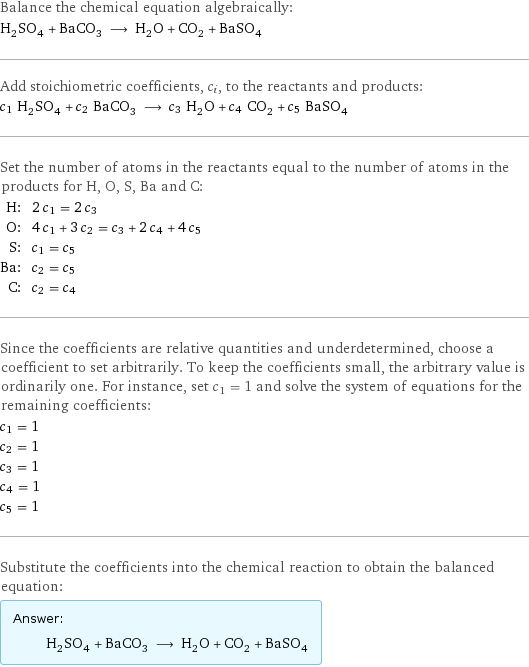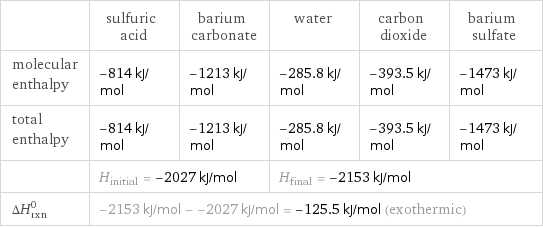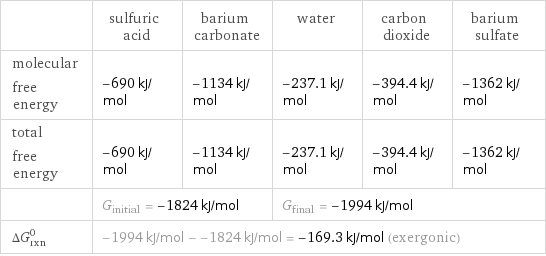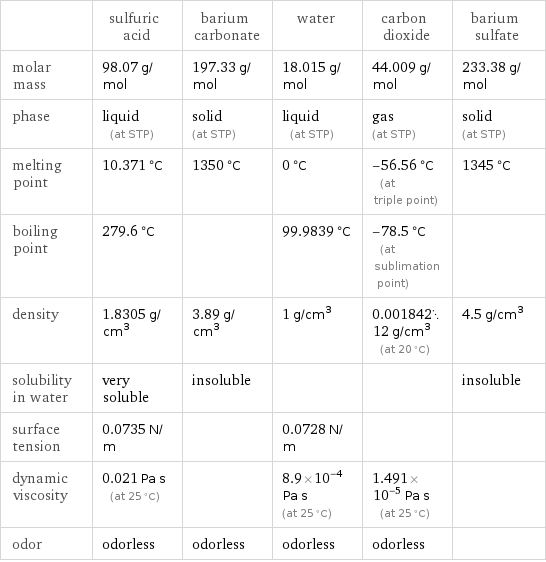Input interpretation

H_2SO_4 sulfuric acid + BaCO_3 barium carbonate ⟶ H_2O water + CO_2 carbon dioxide + BaSO_4 barium sulfate
Balanced equation

Balance the chemical equation algebraically: H_2SO_4 + BaCO_3 ⟶ H_2O + CO_2 + BaSO_4 Add stoichiometric coefficients, c_i, to the reactants and products: c_1 H_2SO_4 + c_2 BaCO_3 ⟶ c_3 H_2O + c_4 CO_2 + c_5 BaSO_4 Set the number of atoms in the reactants equal to the number of atoms in the products for H, O, S, Ba and C: H: | 2 c_1 = 2 c_3 O: | 4 c_1 + 3 c_2 = c_3 + 2 c_4 + 4 c_5 S: | c_1 = c_5 Ba: | c_2 = c_5 C: | c_2 = c_4 Since the coefficients are relative quantities and underdetermined, choose a coefficient to set arbitrarily. To keep the coefficients small, the arbitrary value is ordinarily one. For instance, set c_1 = 1 and solve the system of equations for the remaining coefficients: c_1 = 1 c_2 = 1 c_3 = 1 c_4 = 1 c_5 = 1 Substitute the coefficients into the chemical reaction to obtain the balanced equation: Answer: | | H_2SO_4 + BaCO_3 ⟶ H_2O + CO_2 + BaSO_4
Structures

+ ⟶ + +
Names

sulfuric acid + barium carbonate ⟶ water + carbon dioxide + barium sulfate
Reaction thermodynamics
Enthalpy

| sulfuric acid | barium carbonate | water | carbon dioxide | barium sulfate molecular enthalpy | -814 kJ/mol | -1213 kJ/mol | -285.8 kJ/mol | -393.5 kJ/mol | -1473 kJ/mol total enthalpy | -814 kJ/mol | -1213 kJ/mol | -285.8 kJ/mol | -393.5 kJ/mol | -1473 kJ/mol | H_initial = -2027 kJ/mol | | H_final = -2153 kJ/mol | | ΔH_rxn^0 | -2153 kJ/mol - -2027 kJ/mol = -125.5 kJ/mol (exothermic) | | | |
Gibbs free energy

| sulfuric acid | barium carbonate | water | carbon dioxide | barium sulfate molecular free energy | -690 kJ/mol | -1134 kJ/mol | -237.1 kJ/mol | -394.4 kJ/mol | -1362 kJ/mol total free energy | -690 kJ/mol | -1134 kJ/mol | -237.1 kJ/mol | -394.4 kJ/mol | -1362 kJ/mol | G_initial = -1824 kJ/mol | | G_final = -1994 kJ/mol | | ΔG_rxn^0 | -1994 kJ/mol - -1824 kJ/mol = -169.3 kJ/mol (exergonic) | | | |
Entropy

| sulfuric acid | barium carbonate | water | carbon dioxide | barium sulfate molecular entropy | 157 J/(mol K) | 112 J/(mol K) | 69.91 J/(mol K) | 214 J/(mol K) | 132 J/(mol K) total entropy | 157 J/(mol K) | 112 J/(mol K) | 69.91 J/(mol K) | 214 J/(mol K) | 132 J/(mol K) | S_initial = 269 J/(mol K) | | S_final = 415.9 J/(mol K) | | ΔS_rxn^0 | 415.9 J/(mol K) - 269 J/(mol K) = 146.9 J/(mol K) (endoentropic) | | | |
Equilibrium constant
![Construct the equilibrium constant, K, expression for: H_2SO_4 + BaCO_3 ⟶ H_2O + CO_2 + BaSO_4 Plan: • Balance the chemical equation. • Determine the stoichiometric numbers. • Assemble the activity expression for each chemical species. • Use the activity expressions to build the equilibrium constant expression. Write the balanced chemical equation: H_2SO_4 + BaCO_3 ⟶ H_2O + CO_2 + BaSO_4 Assign stoichiometric numbers, ν_i, using the stoichiometric coefficients, c_i, from the balanced chemical equation in the following manner: ν_i = -c_i for reactants and ν_i = c_i for products: chemical species | c_i | ν_i H_2SO_4 | 1 | -1 BaCO_3 | 1 | -1 H_2O | 1 | 1 CO_2 | 1 | 1 BaSO_4 | 1 | 1 Assemble the activity expressions accounting for the state of matter and ν_i: chemical species | c_i | ν_i | activity expression H_2SO_4 | 1 | -1 | ([H2SO4])^(-1) BaCO_3 | 1 | -1 | ([BaCO3])^(-1) H_2O | 1 | 1 | [H2O] CO_2 | 1 | 1 | [CO2] BaSO_4 | 1 | 1 | [BaSO4] The equilibrium constant symbol in the concentration basis is: K_c Mulitply the activity expressions to arrive at the K_c expression: Answer: | | K_c = ([H2SO4])^(-1) ([BaCO3])^(-1) [H2O] [CO2] [BaSO4] = ([H2O] [CO2] [BaSO4])/([H2SO4] [BaCO3])](../image_source/f0e6d76406437adb54ede0d4d4d265ca.png)
Construct the equilibrium constant, K, expression for: H_2SO_4 + BaCO_3 ⟶ H_2O + CO_2 + BaSO_4 Plan: • Balance the chemical equation. • Determine the stoichiometric numbers. • Assemble the activity expression for each chemical species. • Use the activity expressions to build the equilibrium constant expression. Write the balanced chemical equation: H_2SO_4 + BaCO_3 ⟶ H_2O + CO_2 + BaSO_4 Assign stoichiometric numbers, ν_i, using the stoichiometric coefficients, c_i, from the balanced chemical equation in the following manner: ν_i = -c_i for reactants and ν_i = c_i for products: chemical species | c_i | ν_i H_2SO_4 | 1 | -1 BaCO_3 | 1 | -1 H_2O | 1 | 1 CO_2 | 1 | 1 BaSO_4 | 1 | 1 Assemble the activity expressions accounting for the state of matter and ν_i: chemical species | c_i | ν_i | activity expression H_2SO_4 | 1 | -1 | ([H2SO4])^(-1) BaCO_3 | 1 | -1 | ([BaCO3])^(-1) H_2O | 1 | 1 | [H2O] CO_2 | 1 | 1 | [CO2] BaSO_4 | 1 | 1 | [BaSO4] The equilibrium constant symbol in the concentration basis is: K_c Mulitply the activity expressions to arrive at the K_c expression: Answer: | | K_c = ([H2SO4])^(-1) ([BaCO3])^(-1) [H2O] [CO2] [BaSO4] = ([H2O] [CO2] [BaSO4])/([H2SO4] [BaCO3])
Rate of reaction
![Construct the rate of reaction expression for: H_2SO_4 + BaCO_3 ⟶ H_2O + CO_2 + BaSO_4 Plan: • Balance the chemical equation. • Determine the stoichiometric numbers. • Assemble the rate term for each chemical species. • Write the rate of reaction expression. Write the balanced chemical equation: H_2SO_4 + BaCO_3 ⟶ H_2O + CO_2 + BaSO_4 Assign stoichiometric numbers, ν_i, using the stoichiometric coefficients, c_i, from the balanced chemical equation in the following manner: ν_i = -c_i for reactants and ν_i = c_i for products: chemical species | c_i | ν_i H_2SO_4 | 1 | -1 BaCO_3 | 1 | -1 H_2O | 1 | 1 CO_2 | 1 | 1 BaSO_4 | 1 | 1 The rate term for each chemical species, B_i, is 1/ν_i(Δ[B_i])/(Δt) where [B_i] is the amount concentration and t is time: chemical species | c_i | ν_i | rate term H_2SO_4 | 1 | -1 | -(Δ[H2SO4])/(Δt) BaCO_3 | 1 | -1 | -(Δ[BaCO3])/(Δt) H_2O | 1 | 1 | (Δ[H2O])/(Δt) CO_2 | 1 | 1 | (Δ[CO2])/(Δt) BaSO_4 | 1 | 1 | (Δ[BaSO4])/(Δt) (for infinitesimal rate of change, replace Δ with d) Set the rate terms equal to each other to arrive at the rate expression: Answer: | | rate = -(Δ[H2SO4])/(Δt) = -(Δ[BaCO3])/(Δt) = (Δ[H2O])/(Δt) = (Δ[CO2])/(Δt) = (Δ[BaSO4])/(Δt) (assuming constant volume and no accumulation of intermediates or side products)](../image_source/67fd11deead9ed82ec875ff8ab815b77.png)
Construct the rate of reaction expression for: H_2SO_4 + BaCO_3 ⟶ H_2O + CO_2 + BaSO_4 Plan: • Balance the chemical equation. • Determine the stoichiometric numbers. • Assemble the rate term for each chemical species. • Write the rate of reaction expression. Write the balanced chemical equation: H_2SO_4 + BaCO_3 ⟶ H_2O + CO_2 + BaSO_4 Assign stoichiometric numbers, ν_i, using the stoichiometric coefficients, c_i, from the balanced chemical equation in the following manner: ν_i = -c_i for reactants and ν_i = c_i for products: chemical species | c_i | ν_i H_2SO_4 | 1 | -1 BaCO_3 | 1 | -1 H_2O | 1 | 1 CO_2 | 1 | 1 BaSO_4 | 1 | 1 The rate term for each chemical species, B_i, is 1/ν_i(Δ[B_i])/(Δt) where [B_i] is the amount concentration and t is time: chemical species | c_i | ν_i | rate term H_2SO_4 | 1 | -1 | -(Δ[H2SO4])/(Δt) BaCO_3 | 1 | -1 | -(Δ[BaCO3])/(Δt) H_2O | 1 | 1 | (Δ[H2O])/(Δt) CO_2 | 1 | 1 | (Δ[CO2])/(Δt) BaSO_4 | 1 | 1 | (Δ[BaSO4])/(Δt) (for infinitesimal rate of change, replace Δ with d) Set the rate terms equal to each other to arrive at the rate expression: Answer: | | rate = -(Δ[H2SO4])/(Δt) = -(Δ[BaCO3])/(Δt) = (Δ[H2O])/(Δt) = (Δ[CO2])/(Δt) = (Δ[BaSO4])/(Δt) (assuming constant volume and no accumulation of intermediates or side products)
Chemical names and formulas

| sulfuric acid | barium carbonate | water | carbon dioxide | barium sulfate formula | H_2SO_4 | BaCO_3 | H_2O | CO_2 | BaSO_4 Hill formula | H_2O_4S | CBaO_3 | H_2O | CO_2 | BaO_4S name | sulfuric acid | barium carbonate | water | carbon dioxide | barium sulfate IUPAC name | sulfuric acid | barium(+2) cation carbonate | water | carbon dioxide | barium(+2) cation sulfate
Substance properties

| sulfuric acid | barium carbonate | water | carbon dioxide | barium sulfate molar mass | 98.07 g/mol | 197.33 g/mol | 18.015 g/mol | 44.009 g/mol | 233.38 g/mol phase | liquid (at STP) | solid (at STP) | liquid (at STP) | gas (at STP) | solid (at STP) melting point | 10.371 °C | 1350 °C | 0 °C | -56.56 °C (at triple point) | 1345 °C boiling point | 279.6 °C | | 99.9839 °C | -78.5 °C (at sublimation point) | density | 1.8305 g/cm^3 | 3.89 g/cm^3 | 1 g/cm^3 | 0.00184212 g/cm^3 (at 20 °C) | 4.5 g/cm^3 solubility in water | very soluble | insoluble | | | insoluble surface tension | 0.0735 N/m | | 0.0728 N/m | | dynamic viscosity | 0.021 Pa s (at 25 °C) | | 8.9×10^-4 Pa s (at 25 °C) | 1.491×10^-5 Pa s (at 25 °C) | odor | odorless | odorless | odorless | odorless |
Units
